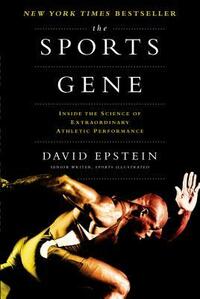Take a photo of a barcode or cover
168 reviews for:
The Sports Gene: Inside the Science of Extraordinary Athletic Performance
David Epstein
168 reviews for:
The Sports Gene: Inside the Science of Extraordinary Athletic Performance
David Epstein
Title makes you think it might be shallow thesis like Outliers, but it's an in-depth survey of both nature, nurture and epigentics. The only weakness of the book is that it's such a broad survey that might seem a bit meandering.
informative
medium-paced
This book covers the impact of genetics vs training (the “10,000 hour rule”) on sports performance and is at its best utterly fascinating and at its worse, desperately needing editing and conciseness (I screamed multiple times- “get to the point”).
One of the more interesting things covered in the book is the finding around genetics impact on training and natural talent. One constant in sports narrative is we deride the athletes that seem to have natural talent but don’t improve (“throwing it away!”) but praise athletes that appear to have achieved their success through “hard work.” Turns out: both of these things are determined by genetics. A person can have a high floor of talent, but almost no ability to improve (low ceiling) and the opposite can also be true (low floor, high ceiling).
One of the more interesting things covered in the book is the finding around genetics impact on training and natural talent. One constant in sports narrative is we deride the athletes that seem to have natural talent but don’t improve (“throwing it away!”) but praise athletes that appear to have achieved their success through “hard work.” Turns out: both of these things are determined by genetics. A person can have a high floor of talent, but almost no ability to improve (low ceiling) and the opposite can also be true (low floor, high ceiling).
informative
inspiring
reflective
medium-paced
Great look at what might give some people athletic advantage. Looks at the 10,000 hours "rule" as well as genetic traits. Very heavy on the running side, but still a fascinating run. Both inspiring and crushing. Also gives me a great excuse for why I'm a horrible runner...
I was given this book to read for a class in the summer. If not, I would have never thought about picking this book up. I was pleasantly surprised by how much I actually enjoyed reading this book. It not only goes into depth of how every single persons genes plays a part on their athleticism but how they came to be and how they could, initially be fine tuned.
It did a good job at seeing the physiology of things, since I am studying Sport Medicine that aspect was interesting and very informative.
Every story told in the chapters was so intriguing as well. We got to learn from a variety of athletes, not just world class champions, and to see how the climate and way of life others live can influence our athleticism.
I would recommend this book to anyone, it's informative and fun but not to the point you feel like you're reading a textbook. Yet your growth in knowledge will come out the same.
It did a good job at seeing the physiology of things, since I am studying Sport Medicine that aspect was interesting and very informative.
Every story told in the chapters was so intriguing as well. We got to learn from a variety of athletes, not just world class champions, and to see how the climate and way of life others live can influence our athleticism.
I would recommend this book to anyone, it's informative and fun but not to the point you feel like you're reading a textbook. Yet your growth in knowledge will come out the same.
This was a really interesting dive into the subject matter. My only criticism would be it didn’t seem to have a central argument or point - it’s more of a dive around all the key salient factors with reference to specific cases. It’s the latter that make the book interesting though - this is the first non-fiction book I’ve read in a while where pretty much every chapter I would recount some interesting fact or event to my other half. Well worth reading for anyone interested in physical performance.
informative
medium-paced
Enjoyed listening to, had some good interesting case studies and science behind athleticism, I would recommend as a solid nonfiction book for people interested in sports. But also in the audiobook the author tries to do accents that are just horrible. Just get a second narrator to indicate it’s a quote please don’t try to do everyone’s accent
Now that this book has some age, I didn't realize how frequently it (and the studies it illuminates) had been brought in popular culture. An enjoyable read for athletic enthusiasts.
This book was an interesting look at the science behind various aspects of sports. Some of this material was familiar from Sports Illustrated articles, not surprising, since the author writes for the magazine. It delves into the research in skill acquisition as well as some of the genetic research behind strength, endurance, and explosive speed. It does a good job of addressing the topic and delving into the potentially thorny issues of race, ethnicity, and athletic ability in a delicate manner.
The chapter which I found most fascinating was biometric differences between the sexes. For example, men generally have a longer forearm in relation to their body size, which has advantages in making more forceful throwing motions. This chapter also discusses women athletes who actually have XY sex chromosomes. This is often accompanied by androgen insensitivity, meaning that their bodies do not respond to testosterone. They developed as females. Similarly certain males have XX sex chromosomes. Interestingly, based on percentages women with XY and androgen insensitivity are overrepresented at the highest levels of competition (1 in ~450 in the Olympics, 1 in 20,00 to 1 in 64,000 typically). Women with the condition are often taller on average and have longer limbs. XY women also are overrepresented in high-level modeling.
A fascinating read, and some researchers from Ohio State and Case Western Reserve Universities are quoted too.
The chapter which I found most fascinating was biometric differences between the sexes. For example, men generally have a longer forearm in relation to their body size, which has advantages in making more forceful throwing motions. This chapter also discusses women athletes who actually have XY sex chromosomes. This is often accompanied by androgen insensitivity, meaning that their bodies do not respond to testosterone. They developed as females. Similarly certain males have XX sex chromosomes. Interestingly, based on percentages women with XY and androgen insensitivity are overrepresented at the highest levels of competition (1 in ~450 in the Olympics, 1 in 20,00 to 1 in 64,000 typically). Women with the condition are often taller on average and have longer limbs. XY women also are overrepresented in high-level modeling.
A fascinating read, and some researchers from Ohio State and Case Western Reserve Universities are quoted too.



